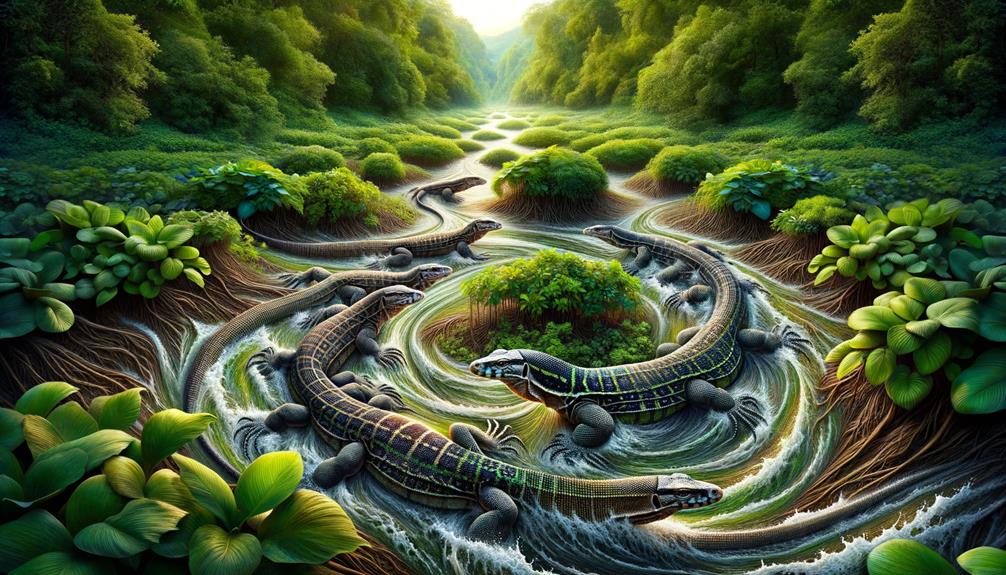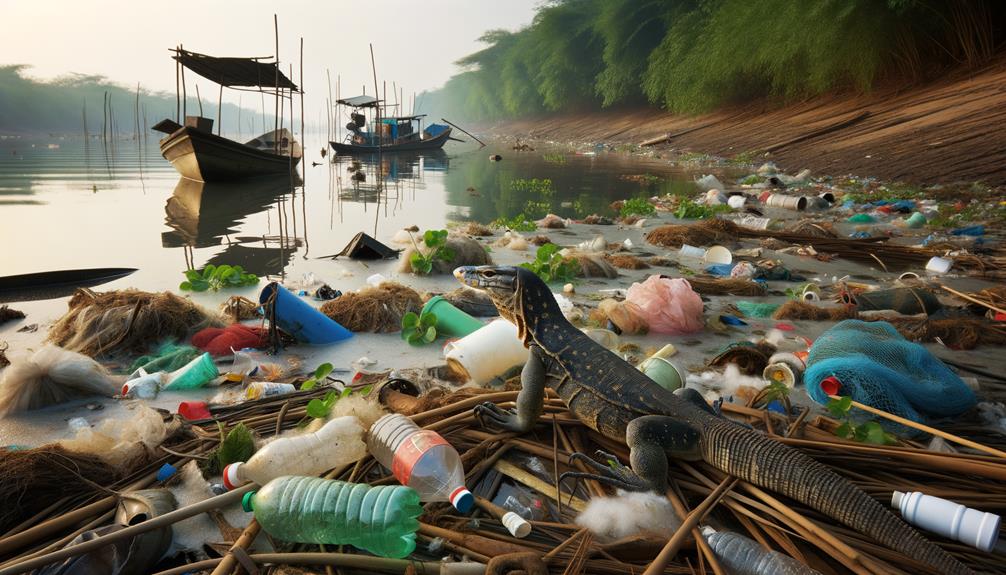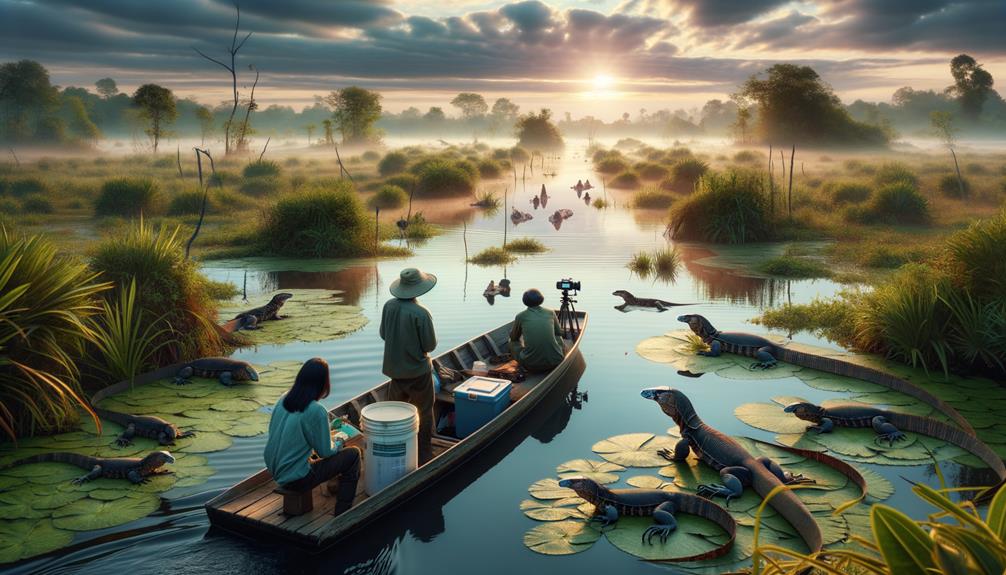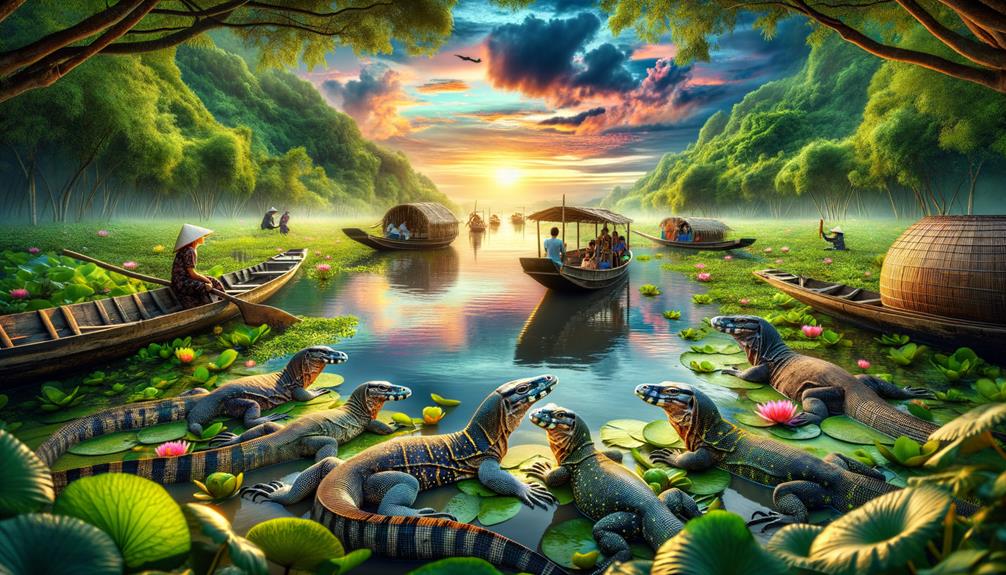Water monitors are proving to be valuable tools in tracking pollution across the Mekong Basin wetlands. After months of data analysis and observation, these hardy creatures have shown a remarkable ability to detect long-lasting organic pollutants in sediment. By pinpointing high-risk areas, these monitors provide crucial information that guides cleanup and conservation work. This approach not only helps maintain water quality but also supports the diverse ecosystem of the wetlands. The potential impact on sustainable development in the region is significant if we can fully utilize their detection capabilities. But how do these monitors actually work, and what are the long-term implications for the area?
Importance of Water Monitors
Water monitors play a key role in tracking pollution in the Mekong Basin wetlands, highlighting their value in environmental protection. These animals help detect persistent organic pollutants (POPs) in sediment, offering insights into the ecosystem's health and revealing toxin buildup in local wildlife.
By tracking POP accumulation, water monitors pinpoint high-risk areas in the Mekong Basin wetlands. This information guides cleanup efforts to where they're most needed. Partnerships with universities and research groups strengthen this work, ensuring well-funded and thorough studies.
As they go about their daily lives, water monitors act as early warning systems for ecological threats that might otherwise slip under the radar. Their health reflects the overall state of the wetlands, providing vital data for developing strategies to reduce pollution. In essence, these animals aren't just inhabitants of the Mekong Basin wetlands—they're valuable partners in our efforts to safeguard these vital ecosystems.
Through their natural behaviors, water monitors become unintentional guardians of their habitat. They alert us to potential issues affecting the wetlands' health, helping researchers and conservationists stay ahead of emerging problems. This real-time feedback is crucial for maintaining the delicate balance of these ecosystems.
The data gathered from water monitors feeds into broader conservation strategies. It helps shape policies, informs public awareness campaigns, and guides restoration projects. By understanding the specific challenges facing different areas of the wetlands, conservationists can tailor their approaches for maximum impact.
In the end, water monitors exemplify how wildlife can contribute to environmental protection. Their role underscores the interconnectedness of ecosystems and the importance of biodiversity in maintaining environmental health. As we continue to face global environmental challenges, the lessons learned from these reptiles in the Mekong Basin wetlands could prove invaluable in protecting ecosystems worldwide.
Hydrological Dynamics in Wetlands

In my research on the Mekong wetlands, I pay close attention to how water levels change, seasonal flow patterns shift, and sediment moves around. These elements are key to understanding the wetlands' inner workings. By keeping tabs on these factors, we get a clear picture of how both nature and human activities affect the health of these ecosystems. This careful monitoring helps us come up with ways to keep these delicate environments in balance. It's a bit like being a detective, piecing together clues from the water and land to solve the puzzle of how these wetlands function and what they need to thrive.
Water Level Variations
Water level changes play a crucial role in wetland ecosystems, particularly in the Mekong region. Tracking these fluctuations helps identify risks and shape conservation strategies.
Data on water levels offers valuable insights. It enables researchers to anticipate how changes might affect the intricate wetland ecosystems. Regular monitoring ensures proper management, supporting both the environment and local communities.
Water level variations impact wetlands in several ways:
| Aspect | Impact of Water Level Changes |
|---|---|
| Biodiversity | Shifts in habitats, affecting species variety |
| Plant Life | Affects growth patterns and overall health |
| Water Quality | Alters nutrient concentrations |
| Soil Erosion | Changes in erosion rates |
| Local Livelihoods | Impacts farming and fishing |
Understanding these complex water dynamics is key. Modeling these changes aids in effective water resource planning, helping maintain the Mekong wetlands' vitality. This approach goes beyond mere preservation; it equips communities with knowledge for sustainable decision-making. By applying these insights, we support both environmental protection and community autonomy.
Seasonal Flow Patterns
The Mekong wetlands pulse with life, their rhythm set by the seasonal ebb and flow of water. Monsoon rains and melting snow create a dynamic environment that's crucial for the area's rich biodiversity. The Mekong River Commission keeps a close eye on these changes, working to maintain the delicate balance of this unique ecosystem.
Water levels rise and fall throughout the year, creating a haven for countless species. Migratory birds and fish depend on these fluctuations for breeding and feeding. As the water moves, it carries nutrients, boosting the wetlands' productivity and supporting diverse wildlife.
Tracking these water patterns is key to understanding how the wetlands might cope with climate change and human activities. By keeping tabs on the water's movements, scientists can predict potential impacts on the ecosystem and plan conservation efforts accordingly.
Key points:
- Monsoon rains and snowmelt drive water patterns
- Changing water levels support diverse wildlife
- Mekong River Commission monitors ecosystem health
Sediment Transport Processes
Water and sediment in the Mekong wetlands work together in a complex way. The movement of sediment, driven by water flows, is key to keeping these wetlands healthy and full of life. Watching how sediment moves helps us understand how nutrients spread, how animal homes form, and how the land changes over time.
Scientists have found that sediment patterns are crucial for protecting wetlands. The Mekong River brings in sediment that feeds the wetlands, creating a base for many plants and animals to live. But when sediment flows change, it can spell trouble. For example, building dams upstream or changing how land is used can alter sediment movement, causing problems like erosion or too much build-up downstream.
To manage wetlands well, we need to grasp these sediment patterns. By finding trouble spots, we can take steps to reduce harm and keep the ecosystem strong. Studying sediment movement not only helps preserve the Mekong wetlands but also protects the wide variety of life that calls this place home.
Biodiversity and Water Levels

The Mekong wetlands, home to a staggering 2,800 species, rely on precise water level tracking to ensure the survival of their ecosystems and the people who depend on them. As part of the Indo-Burma biodiversity hotspot, these wetlands serve as a refuge for countless plants and animals, making conservation efforts crucial. Maintaining optimal water levels keeps these habitats thriving and able to support the diverse life forms that call them home.
Tracking water levels isn't just about science; it's key to sustainable growth. For locals living in and around the Mekong wetlands, healthy ecosystems provide vital resources like clean water, fertile soil, and plentiful fish. These resources, in turn, support local jobs and boost regional food security.
To grasp the significance of this issue, consider these points:
- Species Hub: Mekong wetlands house an impressive array of plants and animals in the Indo-Burma region.
- Vital Habitats: Proper water levels maintain diverse environments essential for both plants and animals.
- Community Support: Healthy wetlands are the backbone of local livelihoods.
Impacts of Human Activities

People are messing up the Mekong wetlands big time, and it's bad news for plants, animals, and locals. Farmers and fish farmers are changing the land, wrecking these key ecosystems. Turning wetlands into rice fields or shrimp farms screws up water flows and adds pollution, hurting the habitat.
In the Delta, folks are pulling out too much groundwater, making the land sink. This sinking makes wetlands flood and erode more, destabilizing the area even more. Cities growing and new buildings in the Mekong region pile on more problems. Roads, bridges, and expanding towns eat up wetland areas, changing them for good.
Cutting down trees for wood and farmland strips the wetlands of important plants. Factory and farm runoff pollutes the water. All these human-caused changes lead to a big drop in plant and animal variety, throwing off the natural balance that countless species, including us, depend on.
Given all this, we need to take a hard look at how we're using land and building stuff in the Mekong. We've got to make protecting these precious wetlands a top priority if we want them around for our kids and grandkids.
Conservation and Management

Protecting the Mekong Delta's wetlands for future generations requires a balanced approach that considers ecology, human needs, and scientific research.
Assessing wetland health involves tracking key species. Fish and amphibian populations can reveal water quality and habitat conditions. In national parks and other protected areas, coordinated water and fire management strategies help maintain ecosystem resilience against natural and human-caused changes.
However, excessive groundwater pumping poses a significant threat. It can cause the land to sink, damaging wetland habitats. To address this, policymakers need to regulate water use and promote sustainable practices.
Practical steps to safeguard these ecosystems include:
- Regular species surveys to gauge overall health
- Comprehensive water and fire management plans
- Strict groundwater extraction limits to prevent land subsidence
Sustainable Practices in the Delta

Sustainable practices in the Mekong Delta need a broad strategy that considers both the environment and local communities. Wetlands here are vital, supporting various species and helping with flood control and water purification.
Recent studies have shown water quality issues in the Lower Mekong Basin, highlighting the need for better practices. This has led to new approaches in national parks, combining water and fire management to protect these key ecosystems.
We're not just preserving; we're also restoring. Wetland restoration projects are tackling climate change head-on. These efforts protect biodiversity and make the region more resilient to extreme weather, safeguarding both nature and people.
In Vietnam, projects that support sustainable livelihoods show our dedication to these goals. They're preserving wetlands for the future and helping local communities adapt to environmental shifts. In the Mekong Delta, sustainable practices and wetland management aren't just trendy terms; they're essential for the survival of both the natural world and the people who call this region home.
Frequently Asked Questions
What Is the Issue With the Water in Mekong River?
The Mekong River faces a serious problem: high levels of toxic chemicals known as Persistent Organic Pollutants (POPs), including DDT and endosulfan. These substances build up in animals and plants over time, creating a ripple effect through the food chain. This accumulation threatens the diverse wildlife in the region and poses potential health risks to local communities who rely on the river for food and livelihood.
Environmental scientists are particularly concerned about the long-term impact of these pollutants on the Mekong's ecosystem. The chemicals' persistence in the environment means their effects could last for generations, potentially altering the delicate balance of this vital waterway.
Local authorities and international organizations are now grappling with how to address this contamination. Efforts are underway to monitor pollution levels, identify sources, and develop strategies to reduce the inflow of these harmful substances into the river system.
What Is the Mekong Water Dispute?
Picture the Mekong: a massive river sustaining millions, now at the center of a heated dispute. Countries are butting heads over dam construction, water management, and the effects on those living downstream. These tensions are only getting worse as the climate shifts and more people need water.
The Mekong Water Dispute boils down to a clash of interests. Upstream nations want to build dams for power and control water flow. Downstream countries worry about how this will affect their fishing, farming, and overall way of life. It's a complex issue with no easy answers.
Climate change is throwing a wrench in the works, making water levels less predictable. More people needing water for crops, industry, and daily life adds to the pressure. The result? A tug-of-war over a vital resource that's becoming increasingly scarce.
This isn't just about water – it's about power, economics, and survival. The choices made about the Mekong will shape the future of Southeast Asia. As the situation heats up, finding a fair solution that works for everyone is proving to be a major challenge.
Are Dams Killing the Mekong River?
Dams are causing significant harm to the Mekong River. These structures disrupt the river's natural flow, decrease sediment movement, and worsen pollution issues. As a result, aquatic ecosystems face serious threats. The river's well-being is crucial for local communities, who depend on it for their daily lives and economic activities. Without a healthy Mekong, these people lose the ability to sustain themselves and maintain their traditional ways of life. The ongoing dam construction along the river raises concerns about long-term environmental impacts and the future of those who call the Mekong region home.
Why Are Dams Being Built on the Mekong River?
Think of controlling the river's power like taming a wild horse. Governments are building dams on the Mekong to address rising power needs, boost economic development, and regulate water supplies. However, these projects often cause issues for communities downstream.



